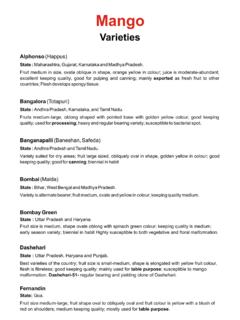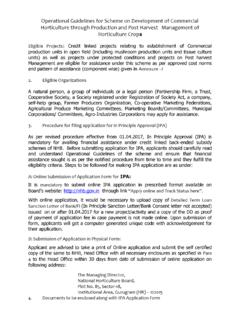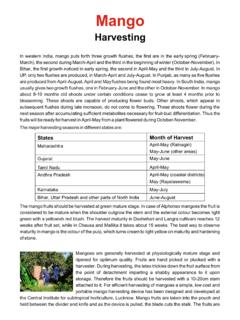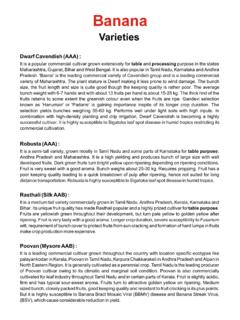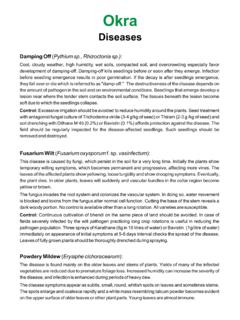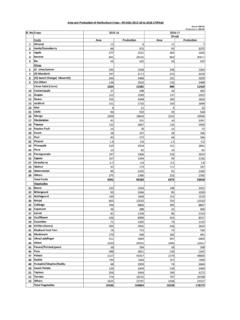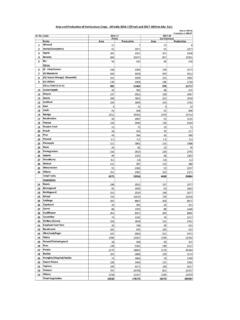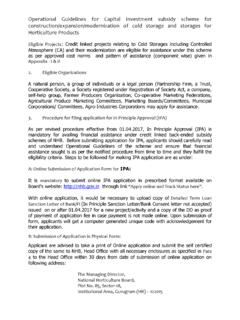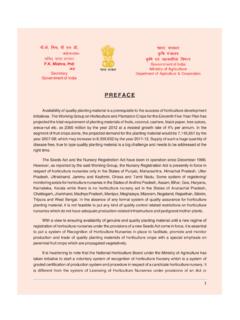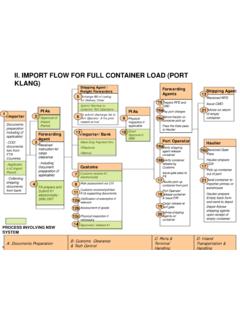Transcription of iii - NHB
1 Iii CONTENTS Sr. No. Description Page No. 1. Preface v-vi 2. Section 1. Technical Standards 1-22 3. Section 2. Basic Data Sheet 23-34 4. Section 3. Protocol for Implementation of Technical Standards 35-37 5. Annexure-I 38-41 6. Annexure-II 42-44 7. Annexure-III 45-54v Preface A Task Force on development of cold chain in India had been set up by the Ministry of Agriculture vide its order dated 3rd May 2007. The said Task Force had recommended revised normative cost for cold storages and subsidy norms for ensuring technology up gradation in cold storages. It has, therefore, been felt necessary to define appropriate technical standards in respect of various components of cold storages without which exercise of quantification of revised normative cost, subsidy norms etc cannot be substantiated; nor can the desired results of effecting technology up gradation be achieved.
2 Therefore, Department of Agriculture & Cooperation, Ministry of Agriculture, Government of India, vide its communication No. 22011/5/2007-M-II dated 16th June 2009 constituted a Technical Standards Committee. Terms of Reference of the Technical Standards Committee (TSC) is to give recommendations on the following issues- (i) Suitable technical standards and protocols for cold chain infrastructure in the Country (ii) The mechanism of implementation of such standards and protocols (iii) Any other issue that the Committee may consider important or relevant for the subject or may be assigned to it by the Government. The Committee was given initial time frame of two months for submitting its recommendations. However, extension up to end of November 2009 was formally granted at a later stage.
3 The TSChas classified cold storages for fruits & vegetables in following three main categories as listed below and is hereby, submitting technical standards etc in respect of the second one of them. Categories of Cold Storage taken up for determining technical standards (i) Cold storages for storage of fresh horticulture products which do not require pre-cooling (ii) Multi-commodity Cold storages for short term and long term storage of fresh horticulture products which require pre-cooling and varying storage requirements (iii) Control Atmosphere (CA) Storages These Standards cover Cold Storage of Type-(ii) mentioned above and have three sections viz. Technical Standards, Basic Data Sheet and Protocol for Implementation of the Prescribed Technical Standards.
4 While firming up its recommendations by TSC, emphasis is laid on optimum energy efficiency and overall performance and therefore coefficient of performance (CoP) is one of the determining criteria. In addition, aspects of environmental and safety concerns and Human Resource Development too have been taken in to account. The Technical Standards have general information on the type of produce that can be stored in particular Type/ module, their critical storage conditions, (as much compatible with the World standards as possible by relying on World Food Logistic Organisation (WFLO) database in absence of research data for Indian conditions) in terms of temperature, humidity range, CO 2 level, loading rate, pull down time, air circulation and ventilation requirement etc.
5 In order to facilitate improved design, there is a detailed Basic Data Sheet available in the Section 2 of the Standards wherein plotting different specification data into a system shall lead to better coefficient1 SECTION I TECHNICAL STANDARDS2 Section-1 Technical Standard for Cold Storage for Fruits and Vegetables requiring Pre-cooling before storage Cold Storage Type these type of cold stores are meant for storing different types fresh fruits and vegetables and other horticulture products which require pre-cooling or rapid room cooling to seven-eighth-cooling in a short time period of 4 hours to 24 hours depending on requirements in order to preserve there freshness, quality and self life. The 7/8 cooling time is the time needed for the product temperature to drop by seven- eighths of the difference between the initial product temperature at the time of loading and the temperature of the cooling air circulating in the cold rooms.
6 In case of room cooling the fresh produce can be cooled and stored in the same room without the need of transfer but it requires that the rooms are properly designed with adequate refrigeration, air circulation and most importantly proper stacking and storage arrangement. However for much faster method of pre-cooling, in case the field heat is required to be removed from the fresh produce within 4 to 6 hours, forced-air cooling is adaptable to a wide range of commodity. This allows the cold air to be in direct contract with the warm produce by moving it through the produce rather than around the containers. Multi commodity cold stores are provided with multiple chambers enabling them to store a wide range of fresh horticulture products together with respect to there storage compability requirements for temperature, relative humidity, atmosphere, protection from odour and sensitivity to other gases like ethylene.
7 The refrigeration system is designed to adjust and operate to a range of temperature and humidity conditions, depending on the compatibility group for storage of fruits and vegetables Efficiency and performance in such cold stores is linked to appropriate storage systems which greatly optimize space, allows uniform air circulation through the produce and meets the fundamental requirements of stock rotation which is time sensitive due to limited shelf life. This becomes more important for the cold stores being set up for the retail trade, export and food processing industry. 1. General recommendations about pre-cooling For most fresh horticulture commodities, one hour time loss at the field temperature of 35 C between harvest and pre-cooling can reduce quality as much as 20 hrs in storage under proper conditions.
8 Delay in pre-cooling results in loss of moisture from the produce causes weight loss and combined with active micro-biological organisms result in deterioration of quality and value loss. The design of the multi-commodity cold store facility and method of pre-cooling depends on various factors like nature of product, category and product type which determines the period of storage for example short term storage (generally refer to as 7 to 10 days storage) or long/medium term storage. Handling, stacking and storage methods, packaging, frequency of entry and exists are also key deciding factors. The requirements of pre-cooling fruits and vegetables are generally classified as under:3 (i). Fruits and vegetables which require on farm pre-cooling if transport time to reach them to cold storage is more than a few hours.
9 It is desirable that fresh produce like grapes, mandarins, berries, cherries, leeches, melons, stone fruits, sapotas, okra, tomatoes, capsicum, chilli peppers, brinjal, cucumbers, green beans, peas, spinach should be cooled as rapidly as possible. (ii). Less perishable fruits & vegetables such as mangoes, papaya, guava, green bananas, pomegranates, radish, cabbage, cauliflower and carrot can be transported from the field and pre-cooled at the cold storage facility. 2. Critical Storage conditions and Grouping of Products i. Pre-cooling- Pre-cooling requirements vary based on produce and method of cooling such as room cool, hydro cool, forced air cooling, evaporative forced air cooling and ice packaging. However, forced air cooling within 4-6 hours is adoptable to a wider range of commodities than any other pre-cooling method and may suffice for most of the produce and therefore, it is taken for recommending general technical standards for pre-cooling system.
10 General recommendations in this regard for 7/8 cool for selected fruits are as follows- Most Appropriate Method of Pre-cooling Fruit Room Cool Hydro Forced Evaporative Package 1+ days cooling Air Forced Air Ice 30 minutes 2-6 hours 2-6 hours to 1 hour Apples x x x Pears x x x Mangoes x x x Citrus x (excluding X mandarins) mandarins Grapes x Lychees x x Melons Water melons x x Cantaloupes only only Cherries x Bananas x x Papayas x x ii. Quality of produce Produce should be mature with required firmness and free from bruises and other external damages. Therefore, for good keeping quality, fresh produce should be carefully handled in all operations including picking, grading and iii. Commodity Storage Conditions- For designing a cold storage, product storage conditions must be defined in terms of critical storage conditions of temperature, relative humidity,presence of CO 2 , ethylene, air circulation, light etc.
